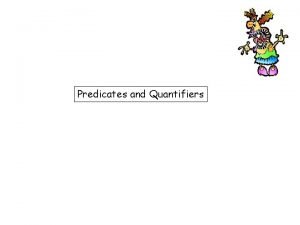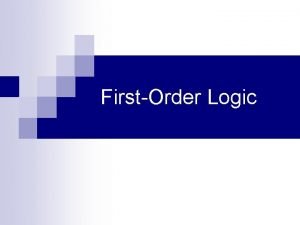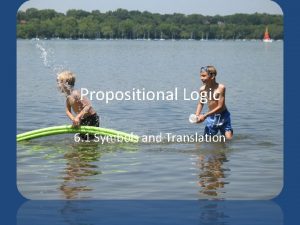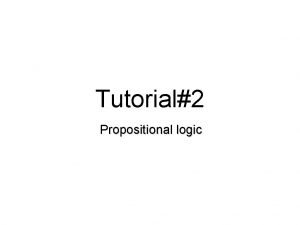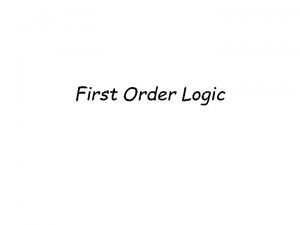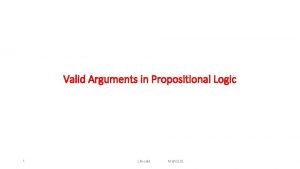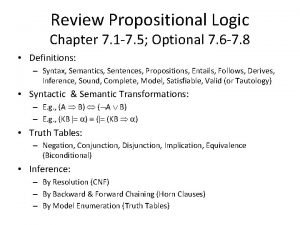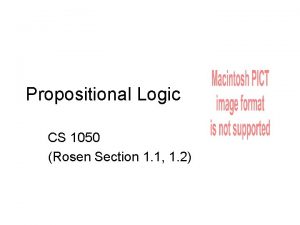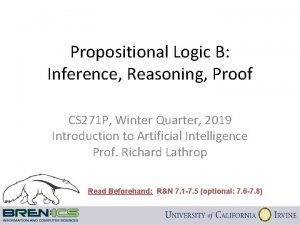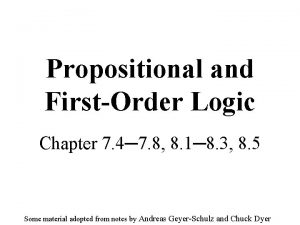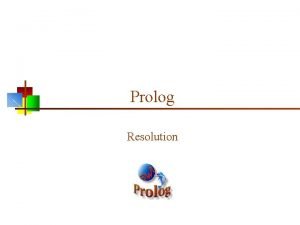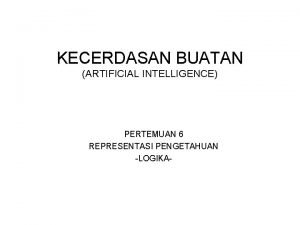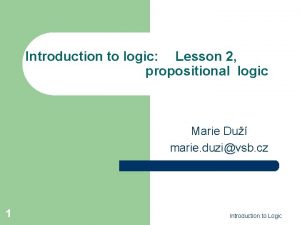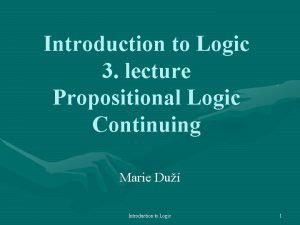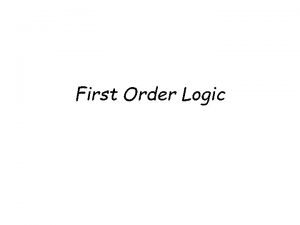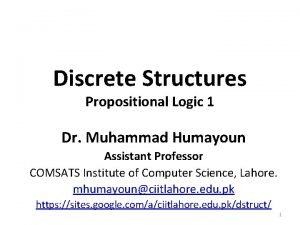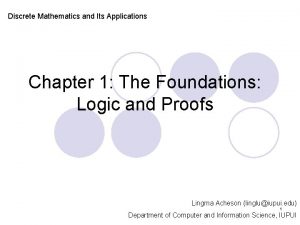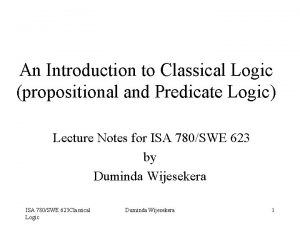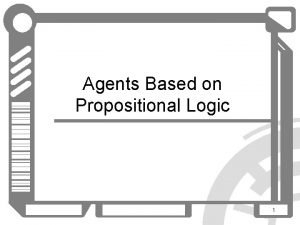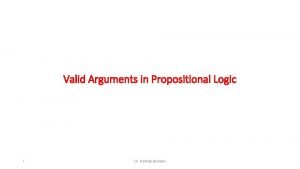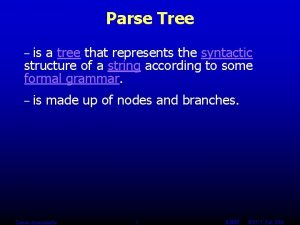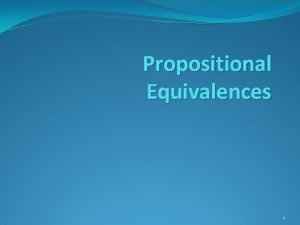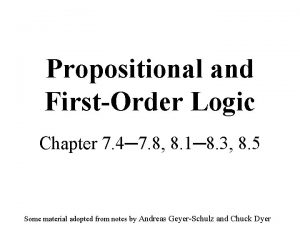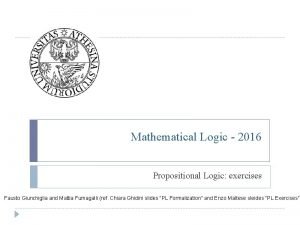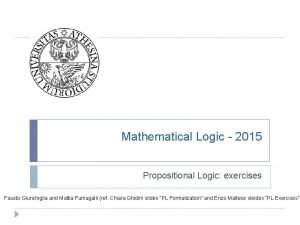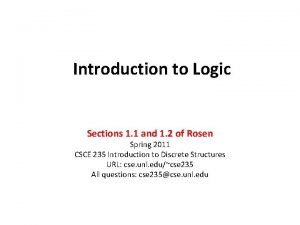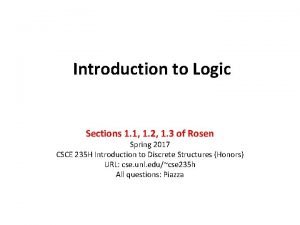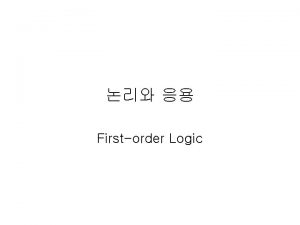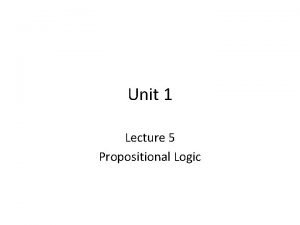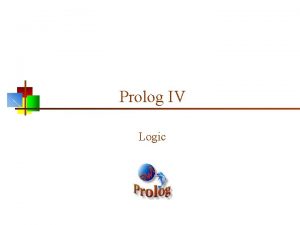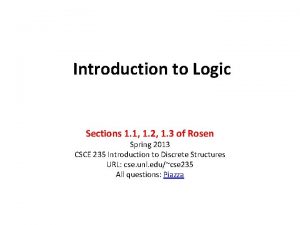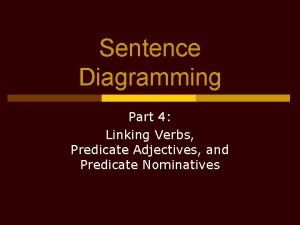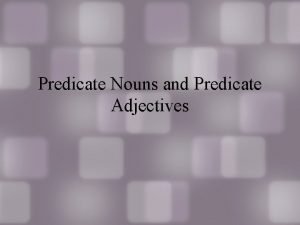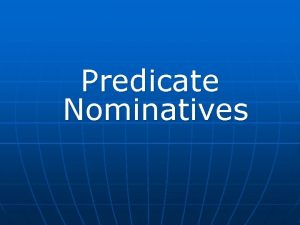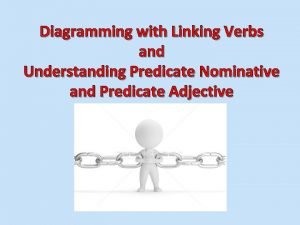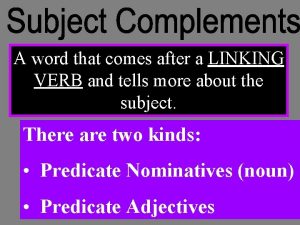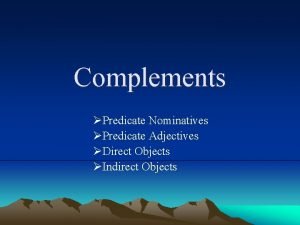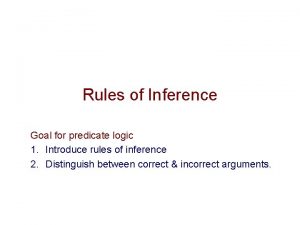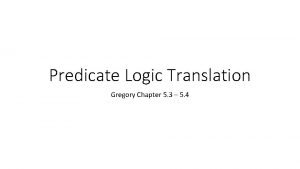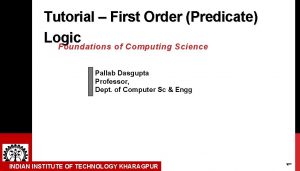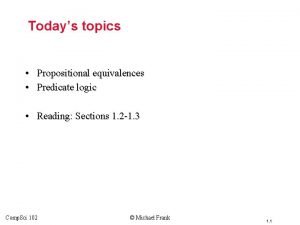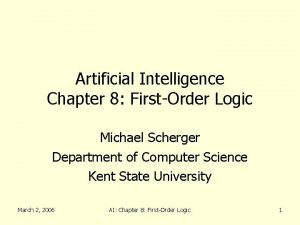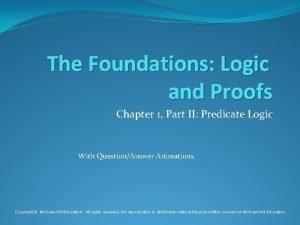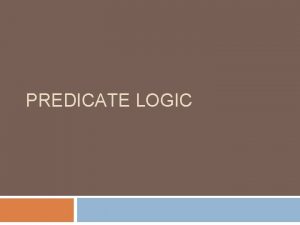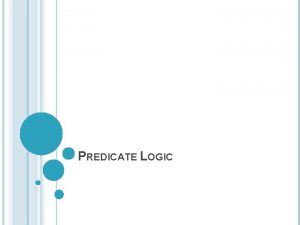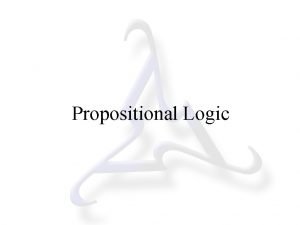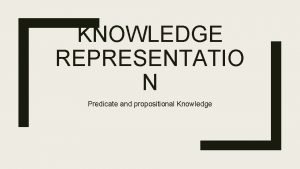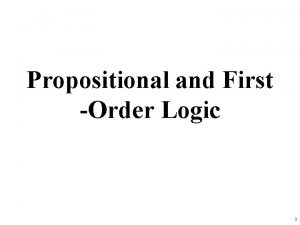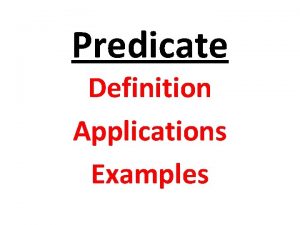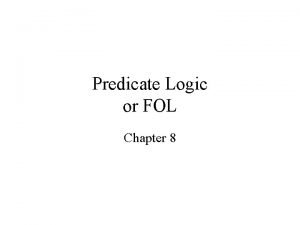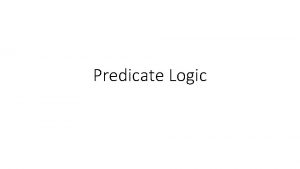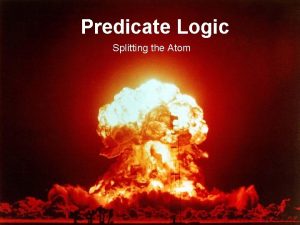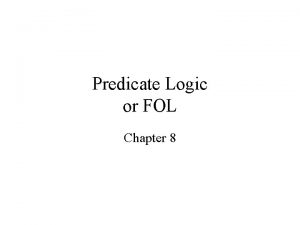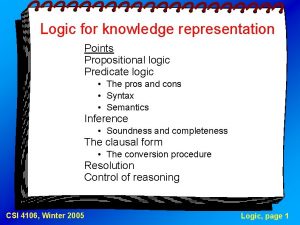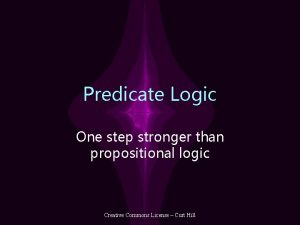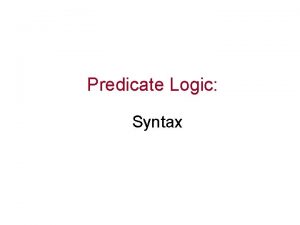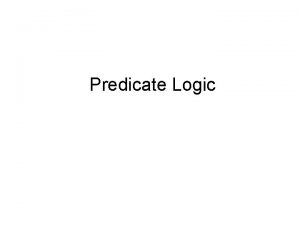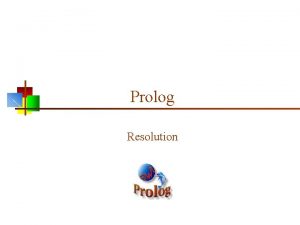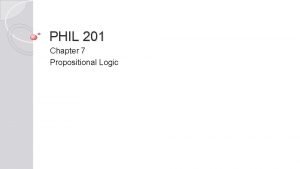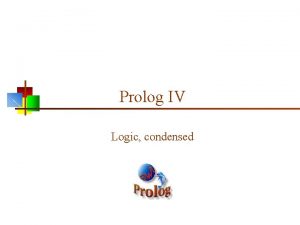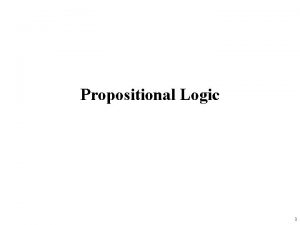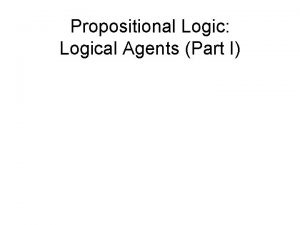An Introduction to Classical Logic propositional and Predicate










![Rules for Disjunction • Introduction A Av. B B Av. B • Elimination [A] Rules for Disjunction • Introduction A Av. B B Av. B • Elimination [A]](https://slidetodoc.com/presentation_image_h2/0a04c467fae9428b68b40f74bca916f1/image-11.jpg)
![Rules for Implication • Introduction [A] B A => B • Elimination (Modus Ponens) Rules for Implication • Introduction [A] B A => B • Elimination (Modus Ponens)](https://slidetodoc.com/presentation_image_h2/0a04c467fae9428b68b40f74bca916f1/image-12.jpg)











![Substituting Terms for Variables • In A[t/x], the free variables of t stand the Substituting Terms for Variables • In A[t/x], the free variables of t stand the](https://slidetodoc.com/presentation_image_h2/0a04c467fae9428b68b40f74bca916f1/image-24.jpg)
![Substituting Terms Continued • • ( A )[t/x] is (A [t/x]) (A ^ B) Substituting Terms Continued • • ( A )[t/x] is (A [t/x]) (A ^ B)](https://slidetodoc.com/presentation_image_h2/0a04c467fae9428b68b40f74bca916f1/image-25.jpg)







![Proof Rules for • Introduction A[t/x] x. A(x) • Elimination [A] B x. A(x) Proof Rules for • Introduction A[t/x] x. A(x) • Elimination [A] B x. A(x)](https://slidetodoc.com/presentation_image_h2/0a04c467fae9428b68b40f74bca916f1/image-33.jpg)

![Example Proof x A(x) ^ B x A(x) [A(t/x)] A(t/x) ^ B x(A(x) ^ Example Proof x A(x) ^ B x A(x) [A(t/x)] A(t/x) ^ B x(A(x) ^](https://slidetodoc.com/presentation_image_h2/0a04c467fae9428b68b40f74bca916f1/image-35.jpg)
![Induction Rule A[0/x] [A(x)] A[x+1/x] A(x) Proviso: x is not free in the assumptions Induction Rule A[0/x] [A(x)] A[x+1/x] A(x) Proviso: x is not free in the assumptions](https://slidetodoc.com/presentation_image_h2/0a04c467fae9428b68b40f74bca916f1/image-36.jpg)















- Slides: 51

An Introduction to Classical Logic (propositional and Predicate Logic) Lecture Notes for ISA 780/SWE 623 by Duminda Wijesekera ISA 780/SWE 623 Classical Logic Duminda Wijesekera 1

Propositional and Predicate Logic • Propositional Logic – The study of statements and their connectivity structure. • Predicate Logic – The study of individuals and their properties. • Study syntax and semantics for both. • Propositional logic more abstract and hence less detailed than predicate logic. ISA 780/SWE 623 Classical Logic Duminda Wijesekera 2

Propositional Logic: Syntax • A collection of atomic propositional symbols. – Say A = { ai : 0 < i }. A special atom _|_ for contradiction • A collection of logical connectives. – (and) ^, (or) v, ( not ) , (implies) => • Inductively define propositions as: If X, Y are propositions, so are : – X ^ Y, X v Y, X => Y, X. • Examples: – a 1^a 2, (a =>a 2)v(a 3^( a 4)) are propositions. ISA 780/SWE 623 Classical Logic Duminda Wijesekera 3

Propositional Logic: Semantics • A model M of a propositional language consists of – a collection of atoms, say B = { bi : 0 < i }, where _|_ is excluded from B, and – a partial mapping M from A = { ai : 0 < i } to B = { bi : 0 < i }. – If M(ai) e B, we say that ai is true in M. We write “ai is true in M” as M |= ai. (Read M satisfies ai). – ╞ is referred to as the satisfaction relation. ISA 780/SWE 623 Classical Logic Duminda Wijesekera 4

Propositional Semantics: Continued • Extend M, and therefore the satisfaction relation to all propositions using the following inductive definition: – M ╞ X ^ Y iff M ╞ X and M ╞ Y. – M ╞ X v Y iff M ╞ X or M ╞ Y. – M ╞ X => Y if M ╞ X then M ╞ Y. – M ╞ X, if it is not the case that M ╞ X. • Notice usage of truth tables ISA 780/SWE 623 Classical Logic Duminda Wijesekera 5

Propositional Logic: Example • B = { a 1, a 3} where M given as M(a 1) = a 1 and M(a 2) = a 2 has the following properties. – – M ╞ a 1 ^ a 3 M ╞ a 2 M ╞ a 2 => a 4 • M does not satisfy the following propositions. – M ╞ a 4 – M ╞ a 1 => a 4 ISA 780/SWE 623 Classical Logic Duminda Wijesekera 6

Propositional Logic: Proofs • What formulas hold in all models ? • I. e. can we check if a given proposition is true in all models without going through all possible models? • Need proofs to answer this question. • We use Natural Deduction proofs. • Recommended: Read Ch 2 of Logic and Computation by L. C. Paulson. ISA 780/SWE 623 Classical Logic Duminda Wijesekera 7

Natural Deduction for Prop. Logic • Proofs are trees of formulae made by applying inference rules. • An inference rule is of the form: A 1 …… An B • Here A 1 …. . An are said to be premises (or antecedents) of the rule, and B is said to be the conclusion (consequent) of the rule. ISA 780/SWE 623 Classical Logic Duminda Wijesekera 8

Natural Deduction for Prop. Logic • Hence a proofs is a trees whose – Root is theorem to be proved, – Branches are rules, and – Leaves are the assumptions (axioms) of the proof. • Example – A 1 A 2 A 3 C 1 C 2 B 1 B 2 D Assumptions Applications of rules Theorem being proved • There are introduction and elimination rules for each connective in Natural Deduction proof systems. ISA 780/SWE 623 Classical Logic Duminda Wijesekera 9

Rules for Conjunction • Introduction A B A^B • Elimination A^B A ISA 780/SWE 623 Classical Logic A^B B Duminda Wijesekera 10
![Rules for Disjunction Introduction A Av B B Av B Elimination A Rules for Disjunction • Introduction A Av. B B Av. B • Elimination [A]](https://slidetodoc.com/presentation_image_h2/0a04c467fae9428b68b40f74bca916f1/image-11.jpg)
Rules for Disjunction • Introduction A Av. B B Av. B • Elimination [A] C Av. B [B] C C • [X] denotes discharged assumption X. ISA 780/SWE 623 Classical Logic Duminda Wijesekera 11
![Rules for Implication Introduction A B A B Elimination Modus Ponens Rules for Implication • Introduction [A] B A => B • Elimination (Modus Ponens)](https://slidetodoc.com/presentation_image_h2/0a04c467fae9428b68b40f74bca916f1/image-12.jpg)
Rules for Implication • Introduction [A] B A => B • Elimination (Modus Ponens) A => B A B ISA 780/SWE 623 Classical Logic Duminda Wijesekera 12

Rules for Negation • B interpreted as ( B => _|_). Hence we get the following rules from those of implication. • Introduction Elimination B B _|_ [B] _|_ ____ B • Special Contradiction Rule: ISA 780/SWE 623 Classical Logic Duminda Wijesekera B _|_ _____ B 13

Propositional Proofs: Examples • Prove: ( A ^ B ) => (A v B) • Notice: – The outermost connective is =>. Hence, the last step of the proof must be an implication introduction. – That means, we must assume ( A ^ B ) and prove (A v B), and then discharge the assumption by using => introduction rule. – In order to prove (A v B) from ( A ^ B ), we must use v –introduction, and hence must prove either A or B from ( A ^ B ). – This plan forms a skeleton of a proof. ISA 780/SWE 623 Classical Logic Duminda Wijesekera 14

Prop. Proof: Example Continued • Prove: ( A ^ B ) => (A v B) [A ^ B ] A Av. B ( A ^ B ) => (A v B) ^ elimination v introduction => introduction • Proofs are analyzed backwards, I. e. start unraveling the logical structure of the conclusion and work backwards to the assumptions. Draw out a plan based on your analysis and write down the formal proof. ISA 780/SWE 623 Classical Logic Duminda Wijesekera 15

Derived Rules • These are rules derived from other rules. • Example: A^B B^A • Here is the derivation: A^B B^A B A ^ elimination B^ A ^ introduction ISA 780/SWE 623 Classical Logic Duminda Wijesekera 16

Soundness and Completeness • A rule A 1 …… An is said to be sound if for every B model in which all of A 1 …… An are true, then so is B. I. e. if M ╞ A 1 , …… , M |= An, then M ╞ B. • A collection of rules are sound if all rules in the collection is sound. • A collection of rules is complete if M ╞ A for all models M, then A is provable. I. e. there is a proof of A using the given set of rules. (Denoted |R-- A ) where R is the set of rules. ISA 780/SWE 623 Classical Logic Duminda Wijesekera 17

Predicate Logic • Language to describe properties of individuals. • Thus, syntax is able to describe individuals, their properties (relationships) and functions. – These are to be thought of as names of individuals, properties (relationships) and functions. – Models are “incarnations” of these individuals, properties (relationships) and functions. • More detailed than propositional logic. ISA 780/SWE 623 Classical Logic Duminda Wijesekera 18

Predicate Logic: Syntax • A collection of constants– say { ci : i >= 0 }. – Constants are names for individuals. E. g. : 0, 1. – Note: not all individuals in a model have names. • A collection of variables– say { xi : i >= 0 }. – Needed to generically refer to individuals. – Think of them as standing in place of pronouns like it, she. • A collection of function symbols- say { fi : i >= 0 }. – May be of different arities, and may be typed. E. g. : +(x, y) • A collection of predicate symbols- say { pi : i >= 0 }. – May be of different arities. – Encodes properties of individuals. E. g. : prime(x). ISA 780/SWE 623 Classical Logic Duminda Wijesekera 19

Predicate Logic Recursive Definition of Terms • Every variable is a term. • Every constant is a term. • If fi is an n-ary function symbol and t 1, . . , tn are terms, then fi(t 1, . . , tn) is a term. • We use {ti : i <=0 } for the collection of terms. • Examples: – f(x, g(2, y)) is a term, where f, g are function symbols and x, y are variables. – +( x, *(3, y)) is a term in arithmetic usually written as x + (3*y) ISA 780/SWE 623 Classical Logic Duminda Wijesekera 20

Recursive Definition of Formulas • If pi is an n-ary predicate symbol and t 1, . . , tn are terms, then pi(t 1, . . , tn ) is an atomic formula. • If A and B are formulas, then so are: – A ^ B, A v B, A, A => B. – xi A(xi), where xi is a variable. • , are referred to as the universal and existential quantifier, respectively. • A formula that does not have either quantifier is said to be a quantifier free. ISA 780/SWE 623 Classical Logic Duminda Wijesekera 21

Free and bound Variables • In x A(x), the variable x is said to be bound; meaning the name x plays no significant role. (compare with he, she, it) • A variable x occurs bound in a formula if x or x is a part of it. More precisely, x occurs bound in: – y A(y) or y A(y) if x and y are the same variable. – A if x occurs bound in A. – A ^ B, A v B, A => B if x occurs bound in either A or B. ISA 780/SWE 623 Classical Logic Duminda Wijesekera 22

Substitutions • If A is a formula, t is a term and x is a variable, then A[t/x] is the formula obtained by substituting t for x in A. – A[t 1/x 1, … tn/xn] is the formula resulting in simultaneously substituting x 1, …xn by t 1, …tn. – Note: Simultaneous substitution Q(x, y)[x/y, y/x] yields Q(y, x) but iterated substitution Q(x, y)[x/y][y/x] yields Q(y, y). ISA 780/SWE 623 Classical Logic Duminda Wijesekera 23
![Substituting Terms for Variables In Atx the free variables of t stand the Substituting Terms for Variables • In A[t/x], the free variables of t stand the](https://slidetodoc.com/presentation_image_h2/0a04c467fae9428b68b40f74bca916f1/image-24.jpg)
Substituting Terms for Variables • In A[t/x], the free variables of t stand the danger of becoming bound in A. Hence, need a precise definition. – If x is y then y A(y) [x/y] is y A(y). If not let z be a fresh variable (I. e. not in t, x) then ( y A(y) )[t/x] is z (A(z/y) [t/x]). – Similar definition for y A(y). • Examples: – y (y = 1) [y/y] is y (y = 1). Here x is y and t is x. – y (y+1 > x) [2 y+x/x] is z ((z+1>x)[2 y+x/x] I. e. z (z+1>2 y+x). Here t is (2 y+x). ISA 780/SWE 623 Classical Logic Duminda Wijesekera 24
![Substituting Terms Continued A tx is A tx A B Substituting Terms Continued • • ( A )[t/x] is (A [t/x]) (A ^ B)](https://slidetodoc.com/presentation_image_h2/0a04c467fae9428b68b40f74bca916f1/image-25.jpg)
Substituting Terms Continued • • ( A )[t/x] is (A [t/x]) (A ^ B) [t/x] is (A[t/x] ^ B[t/x]) (A v B) [t/x] is (A[t/x] v B[t/x]) (A => B) [t/x] is (A[t/x] => B[t/x]) • Pi(t 1, . . tn) [t/x] is Pi(t 1[t/x], . . tn[t/x]) for predicate symbol Pi. ISA 780/SWE 623 Classical Logic Duminda Wijesekera 25

Predicate Logic: Semantics • A model consists of – A set (of individuals), say A = { ai : i >= 0 }. – A set of total functions Fn = { fni : i >= 0 } on A. • I. e. fni(aj) is some ak for every aj. – A set of predicates Pr = { pri : i >= 0 } over A. • Do not have to be total. • Can have many arities. ISA 780/SWE 623 Classical Logic Duminda Wijesekera 26

Interpreting Syntax • Mapping from Syntax to Semantics: – A mapping m. Cons : { ci : I >= 0 } to A={ai: i >= 0}. • Need not be ONTO A. I. e. there could be unnamed individuals in the semantic domain. – A mapping m. Fun : { fi : I >= 0 } to Fn={fni: i >= 0}. • Need not be onto. I. e. there could be unnamed functions in the semantic domain. – A mapping m. Pred: { pi : I >= 0 } to Pr={pri: i >= 0}. • Need not be onto. I. e. there could be unnamed predicates in the semantic domain. ISA 780/SWE 623 Classical Logic Duminda Wijesekera 27

Interpreting Formulas: naming • We do not interpret formulas with free variables. • In order to interpret quantified formulas, need to expand the syntax by adding a constant in the syntax for each unnamed individual in the model. – I. e. for each ai for which there is no cj such that Fn(cj ) is ai, add a new constant Cai to the syntax. – Now expand the definition of terms to include these new constants. Let new. T = { Nti : i >= 0} be the collection of new terms so defined. ISA 780/SWE 623 Classical Logic Duminda Wijesekera 28

Interpreting Formulas • Let M be a model. We define M ╞ F for every quantified formula as follows. – For every n-ary predicate symbol pi , and every sequence of new variable free terms Nt 1, … Ntn define M ╞ pi(Nt 1, … Ntn ) if and only if m. Pred(pi)(Nt 1, … Ntn ). – I. e. pi(Nt 1, … Ntn ) is true in M if and only if its image under the map m. Pred holds with parameters Nt 1, … Ntn. ISA 780/SWE 623 Classical Logic Duminda Wijesekera 29

Interpreting Formulas: Continued – For every formula A , M ╞ y A(y) if and only if M ╞ A(Nti) for every Nti e new. T. – For every formula A , M ╞ y A(y) if and only if there is some Nti e new. T satisfying M ╞ A(Nti). – M ╞ A ^ B if M ╞ A and M ╞ B. – M ╞ A v B if M ╞ A or M ╞ B. – M ╞ A => B if when M ╞ A then M ╞ B. – M ╞ A if it is not the case that M ╞ A. ISA 780/SWE 623 Classical Logic Duminda Wijesekera 30

Proof Rules for Predicate Logic • Proof rules of introduction and elimination of ^, v, =>, and . • New rules required for introduction and elimination of and quantifiers. ISA 780/SWE 623 Classical Logic Duminda Wijesekera 31

Proof Rules for • Introduction A(x) x A(x) provided x is not free in the assumptions of A • Elimination x A(x) A[t/x] ISA 780/SWE 623 Classical Logic Duminda Wijesekera 32
![Proof Rules for Introduction Atx x Ax Elimination A B x Ax Proof Rules for • Introduction A[t/x] x. A(x) • Elimination [A] B x. A(x)](https://slidetodoc.com/presentation_image_h2/0a04c467fae9428b68b40f74bca916f1/image-33.jpg)
Proof Rules for • Introduction A[t/x] x. A(x) • Elimination [A] B x. A(x) B ISA 780/SWE 623 Classical Logic provided x is not free in B nor in the assumptions of B apart from A Duminda Wijesekera 33

An Example Proof • Prove (( x A(x)) ^ B) => ( x (A(x)^ B)) provided that x is not free in B. • Plan: – Since outer connective is =>, need to use => introduction at the last step. Hence can use ( x A(x)) ^ B as an assumption for the steps above. – Now in order to get x (A(x)^ B) using introduction, we need to get A[t/x] )^ B. – Can use ^ elimination to ( x A(x)) ^ B and obtain B – Can use x elimination to get A[t/x]. ISA 780/SWE 623 Classical Logic Duminda Wijesekera 34
![Example Proof x Ax B x Ax Atx Atx B xAx Example Proof x A(x) ^ B x A(x) [A(t/x)] A(t/x) ^ B x(A(x) ^](https://slidetodoc.com/presentation_image_h2/0a04c467fae9428b68b40f74bca916f1/image-35.jpg)
Example Proof x A(x) ^ B x A(x) [A(t/x)] A(t/x) ^ B x(A(x) ^ B x A(x) ^ B B • The other direction of the proof appears in the handout page 32. ISA 780/SWE 623 Classical Logic Duminda Wijesekera 35
![Induction Rule A0x Ax Ax1x Ax Proviso x is not free in the assumptions Induction Rule A[0/x] [A(x)] A[x+1/x] A(x) Proviso: x is not free in the assumptions](https://slidetodoc.com/presentation_image_h2/0a04c467fae9428b68b40f74bca916f1/image-36.jpg)
Induction Rule A[0/x] [A(x)] A[x+1/x] A(x) Proviso: x is not free in the assumptions of A[x+1/x] apart from A(x). ISA 780/SWE 623 Classical Logic Duminda Wijesekera 36

Equality Reasoning • Rules for equality – Reflexivity axiom: t = t. – Symmetry rule: t= u. u=t – Transitivity rule: s = t t=u. s=u • Congruence laws for each function and predicate symbol, or substitution rules. ISA 780/SWE 623 Classical Logic Duminda Wijesekera 37

Equality Reasoning: Continued • Congruence Law for functions: t 1 = u 1 …. tn = un f(t 1, …. , tn) = f(u 1, …. , un) • Congruence Law for Predicates: t 1 = u 1 …. tn = un p(t 1, …. , tn) p(u 1, …. , un) • Substitution Rule: t = u S[t/x] = S[u/x] ISA 780/SWE 623 Classical Logic Duminda Wijesekera 38

Equality Reasoning: An Example x f(x, x) = x f(g(z), g(z)) = g(z) p(f(g(z), g(z)) p(g(z)) ISA 780/SWE 623 Classical Logic Duminda Wijesekera 39

Many Sorted Logic • Sorts can be introduced to first-order logic – So what we learned is single-sorted first orderlogic • x: Integer [ y: Real divides(x, y) ] – Integer and Real are two different sorts. • x, y: Point z: Line [x ≠ y => is. On(x, y, z)] – Point and Line are sorts ISA 780/SWE 623 Classical Logic Duminda Wijesekera 40

Translating many sorted Logic to one-sorted logic • Create a one-ary predicate for each sort and write the statement as an implication. • Many sorted: – x: Integer [ y: Real divides(x, y) ] • One Sorted: – x y[is. Integer(x) ^ is. Real(y)=>divides(x, y)] • x, y: Point z: Line [x ≠ y => is. On(x, y, z)] – x, y z[ is. Point(x) ^is. Point(y) ^ x ≠ y => is. Line(z) is. On(x, y, z)] ISA 780/SWE 623 Classical Logic Duminda Wijesekera 41

Notations from Z . • In Z x f(x) is written as x f(x) • Sometimes types are also used right after the quantifier, for example: • x : opera · is. Composer(Beethovan, x) . • x: Integer · [ y: Real devides(x, y) ] ISA 780/SWE 623 Classical Logic Duminda Wijesekera 42

Typed Logics • Sorts are expected to be disjoint sets • That implies: – Integers are NOT a subset of Real Numbers • Introducing types are more complicated – Requires that there be type constructors. • Example: Integer Real – Ordered pairs, say ORD • Example – x: ORD, z: Integer z: Real x=(y, z) – Here ( , ) is a type constructor. ISA 780/SWE 623 Classical Logic Duminda Wijesekera 43

Why is this an Issue? • • • How to prove: (x, y) = (a, b) iff x=a and y=b Similar problems occur with sets, lists etc. What is the problem? The equality theory has to be built. Sets create more problems: – Set quantifiers are problematic – Leads to FULL second order logic • No complete Σ 1 proof theory ISA 780/SWE 623 Classical Logic Duminda Wijesekera 44

Using Logic As a Programming Language • Prolog • Datalog • Basic Idea: Use them as Rules – Can specify search • Raises many issues with semantics ISA 780/SWE 623 Classical Logic Duminda Wijesekera 45

What Other Forms of Logics are there? • Can enrich 1 st Order Logic by introducing more connectives • Example: Modal Logic: – Adding two new constructors to reason about possibility and nasality – ◊ and – Syntax: If f is a formula so are ◊ f and f ISA 780/SWE 623 Classical Logic Duminda Wijesekera 46

Applications of Modal Logic • • • Dynamic Logic Temporal Logics Theories of Motion Theories of Change Theories of Knowledge Applications in security – Access control – Delegation • See separate transparency on Modal, Dynamic and Temporal Logics ISA 780/SWE 623 Classical Logic Duminda Wijesekera 47

Other Forms to Enhance 1 st Order Logic • Add Richer Quantifier Structures: – Quantify over subsets of structures and/or relation symbols – Add quantifiers such as there exists infinitely many, or for infinitely many. • Example: – x y factors(x, y) – y prime(y) ISA 780/SWE 623 Classical Logic Duminda Wijesekera 48

Apply existing connectives many more times – infinitary logics • If f 1, … fn, . . are formulas so are – ^ {i=1} fi – v {i=1} fi • Different from having infinitary quantifiers ISA 780/SWE 623 Classical Logic Duminda Wijesekera 49

Restrictions based on Semantics • Can specify the size of models • Infinitary but large models – Such as only those beyond a given cardinal א 1 • Finite model theory – Many applications in computer science – Quantifiers take an entirely different meaning ISA 780/SWE 623 Classical Logic Duminda Wijesekera 50

Those that reject basic assumptions of Classical Logic • Intuitionism • Why is (A → B) v (B → A) a tautology ? – Pigenhole principle in classical truth values • Similar argument for (A 1 → A 2) v (A 2 → A 3) …. (An → An+1) v (An+1 → A 1) • Consequence: P v P does not have to be true! • Infinitely many truth values • Leads to Kripke Semantics with worlds with increasing truth values • Used in the semantics of programming languages and type theories ISA 780/SWE 623 Classical Logic Duminda Wijesekera 51
 First order logic vs propositional logic
First order logic vs propositional logic First order logic vs propositional logic
First order logic vs propositional logic First order logic vs propositional logic
First order logic vs propositional logic How a predicate function become a propositional function?
How a predicate function become a propositional function? Pros and cons of propositional logic
Pros and cons of propositional logic Horseshoe logic
Horseshoe logic Propositional logic examples and solutions
Propositional logic examples and solutions Logical operators in r
Logical operators in r Valid arguments in propositional logic
Valid arguments in propositional logic Xor in propositional logic
Xor in propositional logic Proposition math
Proposition math Xor in propositional logic
Xor in propositional logic Propositional logic notation
Propositional logic notation Implies in propositional logic
Implies in propositional logic Prolog propositional logic
Prolog propositional logic Simbol yang dipakai untuk operator penghubung adalah
Simbol yang dipakai untuk operator penghubung adalah Contradiction formula
Contradiction formula Rezolution v2
Rezolution v2 Logic
Logic Discrete math propositional logic
Discrete math propositional logic Applications of propositional logic
Applications of propositional logic Four components of mathematical system
Four components of mathematical system Xor in propositional logic
Xor in propositional logic Conjunction elimination
Conjunction elimination Agents based on propositional logic
Agents based on propositional logic Valid arguments in propositional logic
Valid arguments in propositional logic Parse tree example
Parse tree example Tautologies contradictions and contingencies
Tautologies contradictions and contingencies Propositional logic signs
Propositional logic signs Propositional logic exercises
Propositional logic exercises Propositional logic exercises
Propositional logic exercises Logical connectives
Logical connectives Propositional logic cheat sheet
Propositional logic cheat sheet ___________ is the limitation of propositional logic
___________ is the limitation of propositional logic Kinship domain in artificial intelligence
Kinship domain in artificial intelligence Simple proposition
Simple proposition Prologiv
Prologiv Implication law
Implication law Linking verbs predicate adjectives and predicate nouns
Linking verbs predicate adjectives and predicate nouns Predicate nouns and predicate adjectives
Predicate nouns and predicate adjectives Predicate nominative and adjective
Predicate nominative and adjective How to diagram predicate nominatives
How to diagram predicate nominatives Predicate adjective and predicate nominative
Predicate adjective and predicate nominative Predicate nominative and predicate adjective
Predicate nominative and predicate adjective Simple subject
Simple subject Predicate logic rules of inference
Predicate logic rules of inference Predicate logic translation
Predicate logic translation Predicate computer science
Predicate computer science Predicate logic equivalence
Predicate logic equivalence The first order chapter 8
The first order chapter 8 Example of predicate logic
Example of predicate logic Predicate negation
Predicate negation



